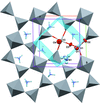issue contents
April 2020 issue

Cover illustration: The salt bis(3-methyl-1-propyl-1H-imidazol-3-ium) bis(4,6-disulfanidyl-4,6-disulfanylidene-1,2,3,5,4,6-tetrathiadiphosphinane-![[kappa]](/logos/entities/kappa_rmgif.gif) 3S2,S4,S6)nickel, [PMIM]2[Ni(P2S8)2] (PMIM = 3-methyl-1-propyl-1H-imidazol-3-ium), was prepared from the elements in the ionic liquid [PMIM]CF3SO3. The structure consists of ordered anions and one ordered PMIM cation. The disordered PMIM cation is found in two orientations that refine to occupancies of roughly 0.80 and 0.20. The isolation of the title compound indicates that well behaved crystals can be obtained from direct reaction of the elements in ionic liquids with propyl chains that might otherwise be considered too prone to poor crystallization. See: Dalecky, Juillerat & Cody [IUCrData (2020). 5, x200312].
3S2,S4,S6)nickel, [PMIM]2[Ni(P2S8)2] (PMIM = 3-methyl-1-propyl-1H-imidazol-3-ium), was prepared from the elements in the ionic liquid [PMIM]CF3SO3. The structure consists of ordered anions and one ordered PMIM cation. The disordered PMIM cation is found in two orientations that refine to occupancies of roughly 0.80 and 0.20. The isolation of the title compound indicates that well behaved crystals can be obtained from direct reaction of the elements in ionic liquids with propyl chains that might otherwise be considered too prone to poor crystallization. See: Dalecky, Juillerat & Cody [IUCrData (2020). 5, x200312].
inorganic compounds


 access
access

 access
accessmetal-organic compounds


 access
access

 access
access

 access
access

 access
accessorganic compounds


 access
access

 access
access

 access
access

 access
access

 access
access

 access
access

 journal menu
journal menu























![[publCIF]](/logos/authorchecklist11.gif)





